Walnut Wood Tables: A Guide to Plank, Live Edge and Epoxy Styles
Walnut wood tables are one of the most popular and versatile choices for dining rooms, kitchens, living rooms and offices. Walnut wood is known for its rich color, fine grain, strength and durability. It can create a warm, elegant and inviting atmosphere in any space.
But not all walnut wood tables are the same. There are different styles of walnut wood tables that can suit different needs and preferences. In this article, we will explore three main styles of walnut wood tables: plank, live edge and epoxy. We will explain what each style is, how it is made, what are its benefits and drawbacks, and how to care for and maintain it. We will also show you some examples of each style from Taitlin Studio, a custom dining tables company and personalized furniture studio based in Nisku, Alberta, Canada.
By the end of this article, you will have a better understanding of walnut wood tables and how to choose the best style for your home.
Key Takeaways
| Style | Description | Benefits | Drawbacks | Maintenance |
|---|---|---|---|---|
| Plank | Made from solid wood planks joined together | Durable, stable, simple, affordable | Prone to seasonal movements if not cared for properly | Use coasters, placemats, tablecloths with heavy use |
| Live Edge | Made from slabs of wood that retain the natural shape and edge of the tree trunk | Unique, beautiful, characterful, organic | Higher cost, limited availability | Avoid direct sunlight and heat sources |
| Epoxy | Made from wood slabs that are filled with epoxy resin to create a smooth and glossy surface | Creative, customizable, durable, resistant to stains, scratches and water damage | Highest cost, more complexity in making, limited availability | Use soft cloths, mild cleaners, avoid abrasive materials and chemicals |
Plank Style Walnut Wood Tables
Plank style tables are one of the most common and traditional styles of dining tables. They are made from solid wood planks that are cut to size and joined together with glue, dowels, tenons or screws. The planks can be arranged in different patterns or directions to create different effects. The edges of the planks can be straight or rounded to create a smooth or rustic look.
Plank style tables have many advantages. They are durable and stable because they are made from solid wood. They are simple and easy to make and assemble. They are also affordable because they use less wood than other styles. Plank style tables can fit in any design theme because they have a classic and timeless appeal.
However, plank style tables also have some drawbacks. They can be affected by changes in moisture and temperature that cause the wood to expand or contract. This can result in warping, cracking or gaps between the planks. Plank style tables also require regular care and maintenance to prevent damage and preserve their beauty. Fortunately, since Alberta has a relatively stable humidity level, we craft our tables in such a way that minimizes any potential issues.
To care for and maintain plank style tables, you should follow these tips:
- Use coasters, placemats or tablecloths to protect the table from spills, stains and scratches.
- Avoid placing hot or cold items directly on the table surface.
- Wipe the table with a damp cloth after each use and dry it thoroughly.
- Avoid exposing the table to direct sunlight or heat sources as they can cause fading or cracking.
Explore our custom plank style walnut wood tables in Edmonton, Calgary, and Vancouver:
Live Edge Walnut Tables
Live edge tables are another popular and distinctive style of wood tables. They are made from slabs of wood that retain the natural shape and edge of the tree trunk. The slabs are cut from logs or reclaimed wood and then sanded, sealed and finished to create a smooth surface. The slabs can vary in size, shape, thickness and color depending on the type and age of the wood.
Live edge tables have many advantages. They are unique and beautiful because they showcase the natural features and character of the wood. They are organic and eco-friendly because they use the whole slab of wood without wasting any material. They are also versatile and adaptable because they can blend in with any design theme, from rustic to modern.
However, live edge tables also have some drawbacks. They are more expensive than other styles because they require more skill and labor to make. They are also more wasteful because they use more wood than other styles. They require more maintenance because they are more prone cracking, splitting, warping if not crafted properly. They can also be difficult to transport and install because they are heavy and bulky.
To care for and maintain live edge tables, you should follow these tips:
- Seal the table with a protective coating to prevent moisture, dirt.
- Clean the table with a soft cloth and a mild cleaner to remove any dust or stains.
- Avoid placing the table near direct sunlight or heat sources as they can cause fading or cracking.
- Use furniture pads or felt pads to protect the table from scratches or dents.
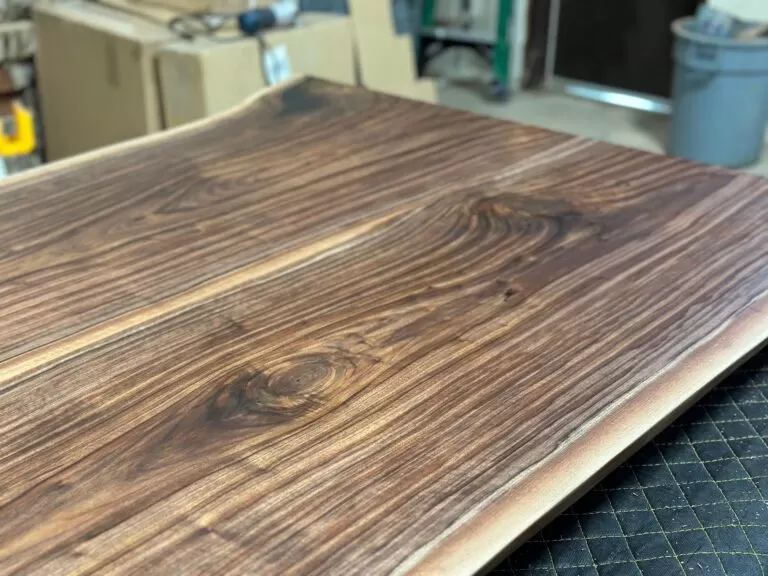
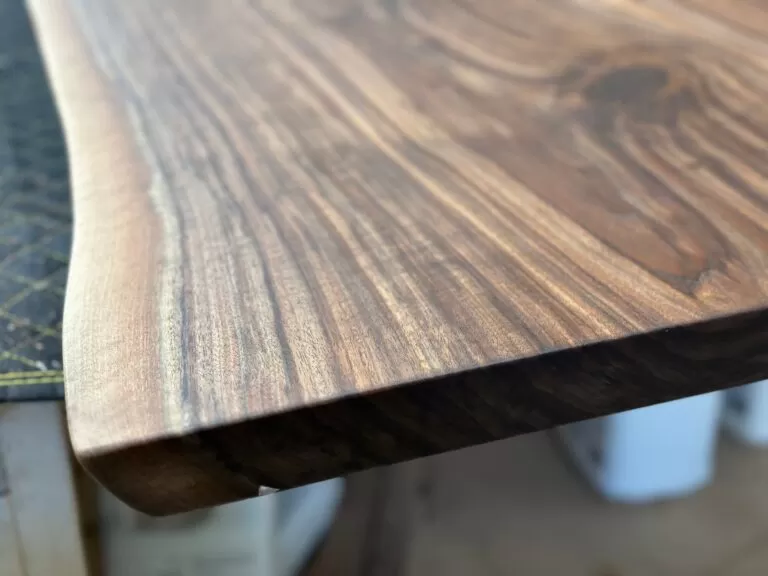
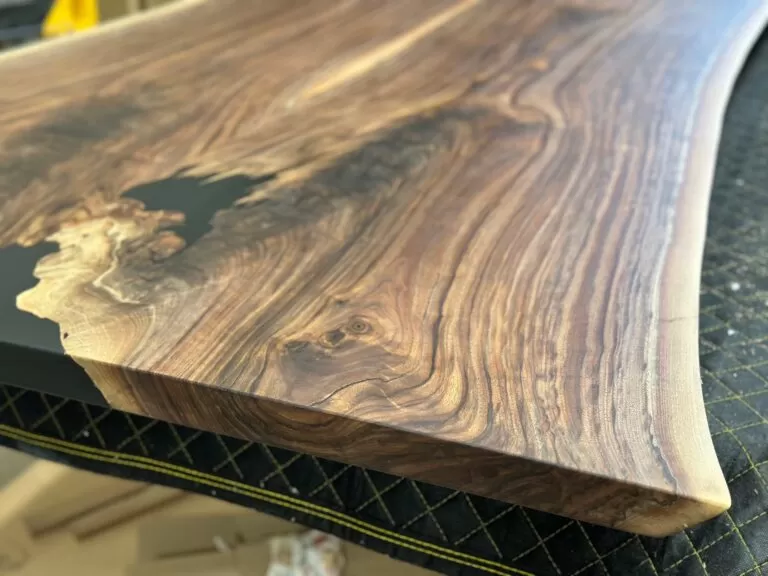
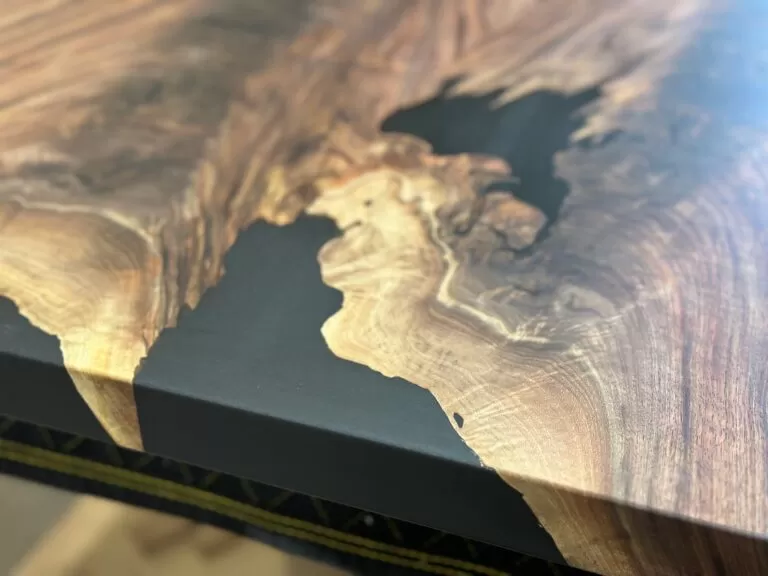
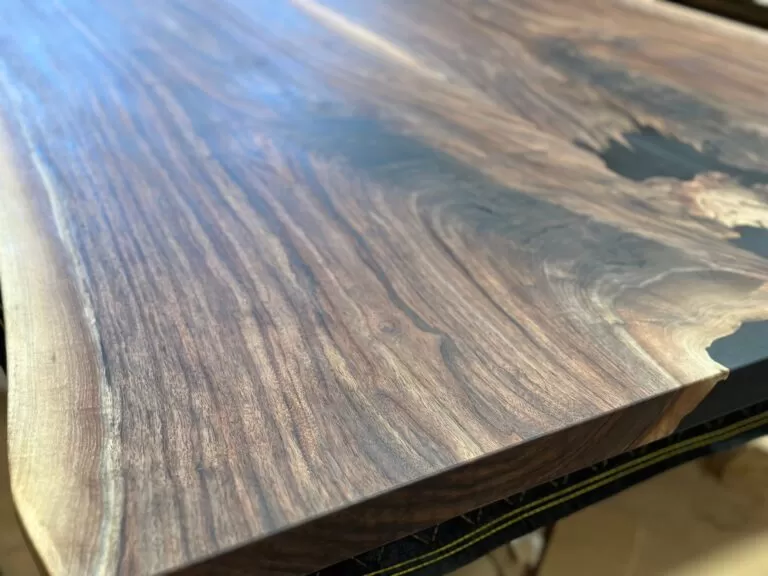
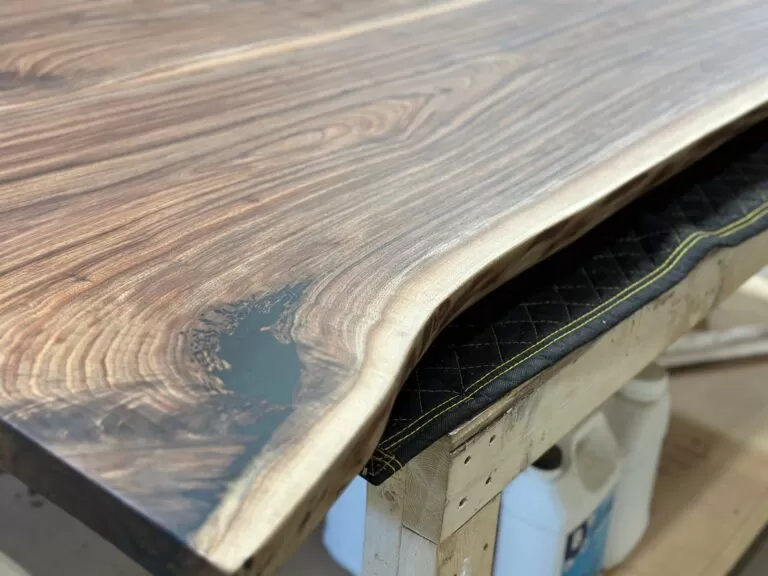
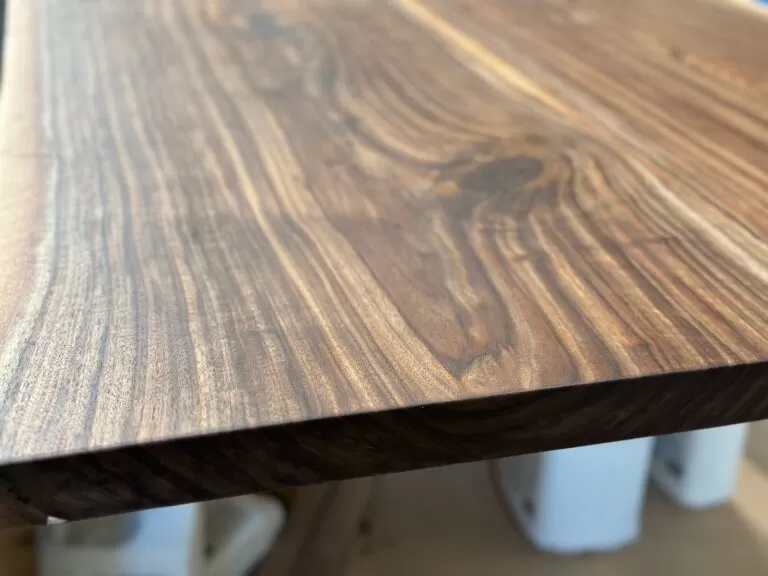

Epoxy Walnut Wood Tables
Epoxy tables are a new and innovative style of wood tables. They are made from wood slabs that are filled with epoxy resin to create a smooth and glossy surface. The epoxy resin can be clear or colored, and it can also contain various objects or materials, such as stones, shells, flowers, glitter, etc. The epoxy resin acts as a filler, a sealer and a finisher for the wood slabs.
Epoxy tables have many advantages. They are creative and customizable because they allow you to create your own design and style with the epoxy resin. They are durable and resistant to stains, scratches and water damage because they have a hard and protective coating. They are also easy to clean and maintain because they have a smooth and non-porous surface.
However, epoxy tables also have some drawbacks. They are more expensive than other styles because they require more materials and equipment to make. They are also more complex and time-consuming to make because they involve multiple steps and curing processes. They are more toxic and hazardous to make because they involve chemicals and fumes that can harm your health and environment. They can also yellow or crack over time due to exposure to UV rays or heat.
To care for and maintain epoxy tables, you should follow these tips:
- Use soft cloths, mild cleaners to clean the table and restore its shine.
- Avoid using abrasive materials or chemicals that can scratch or damage the epoxy coating.
- Avoid placing hot or cold items directly on the table surface as they can cause thermal shock or cracking.
- Avoid exposing the table to direct sunlight or heat sources.

How to Choose the Best Style of Walnut Wood Table for Your Home
Now that you have learned about the three main styles of walnut wood tables: plank, live edge and epoxy, you might be wondering how to choose the best style for your home. There is no definitive answer to this question, as it depends on various factors, such as your budget, space, design theme, functionality and personal taste. However, here are some general guidelines and tips to help you make a decision:
- Budget: The first factor to consider is how much you are willing to spend on a walnut wood table. Generally speaking, epoxy tables are the most expensive, followed by live edge tables and then plank tables. This is because epoxy tables require more materials and equipment, live edge tables require more skill and labor, and plank tables require less wood and complexity. Of course, the price can also vary depending on the size, quality and finish of the table. You should set a realistic budget and stick to it when choosing a style of walnut wood table.
- Space: The second factor to consider is how much space you have in your dining room or kitchen area. You should measure the dimensions of your space and compare them with the dimensions of the table you want. You should also leave enough room for chairs, movement and other furniture. Generally speaking, plank tables are the most compact and adaptable, followed by epoxy tables and then live edge tables. This is because plank tables have straight edges and uniform shapes, epoxy tables have smooth edges and regular shapes, and live edge tables have curved edges and irregular shapes. You should choose a style of walnut wood table that fits your space without overcrowding or underutilizing it.
- Design Theme: The third factor to consider is what kind of look you want to achieve with your walnut wood table. You should think about your existing design theme and how your table will complement or contrast it. Generally speaking, plank tables are the most classic and timeless, followed by live edge tables and then epoxy tables. This is because plank tables have a simple and elegant appeal, live edge tables have a natural and organic appeal, and epoxy tables have a creative and modern appeal. You should choose a style of walnut wood table that matches or enhances your design theme without clashing or overpowering it.
- Functionality: The fourth factor to consider is how often you use your walnut wood table and for what purposes. You should think about your lifestyle and habits and how your table will accommodate them. Generally speaking, epoxy tables are the most durable and resistant, followed by plank tables and then live edge tables. This is because epoxy tables have a hard and protective coating that prevents stains, scratches and water damage, plank tables have a solid and stable structure that prevents warping, cracking and gaps, and live edge tables have a natural and delicate structure that requires more care and maintenance. You should choose a style of walnut wood table that suits your functionality without compromising or sacrificing it.
- Personal Taste: The fifth factor to consider is your personal taste and preference. You should think about what kind of style of walnut wood table you like the most and why. You should also consider the opinions of your family members or guests who will use or see your table. Generally speaking, there is no right or wrong answer to this factor, as it depends on your individual personality and taste. You should choose a style of walnut wood table that makes you happy and satisfied without regretting or resenting it.
Here are some questions to ask yourself before making a decision:
- How much do I want to spend on a walnut wood table?
- How big is my dining room or kitchen area?
- What kind of look do I want to achieve with my walnut wood table?
- How often do I use my walnut wood table and for what purposes?
- What kind of mood or atmosphere do I want to create with my walnut wood table?
The Allure of Walnut: Invoking Feelings of Rich Luxury
Walnut wood is often synonymous with opulence. Its color spectrum ranges from a deep, chocolate brown heartwood to a lighter, yet rich, pale outer wood. This natural contrast creates an immediate impression of luxury, making your table the focal point of any room. The unmatched grain pattern adds another layer of visual interest, revealing intricate swirls, waves, and straight lines that are beautiful in their complexity.
Walnut Versus Walnut Stain: Why Genuine Walnut Makes a Difference
Many people try to mimic the richness of Walnut by using a Walnut stain on less expensive woods. While stains can imitate the color, they cannot replicate the intricate grain, the tactile feel, or the innate warmth of genuine Walnut. Essentially, a Walnut-stained table will always be an imitation of the real thing, lacking the depth and multi-dimensional quality of genuine Walnut wood.
Versatility Across Styles: How Walnut Fits Almost Everywhere
Walnut tables are versatile and fit well within a range of interior design styles—from mid-century modern to rustic farmhouse. However, their warm tones might be too intense for rooms dominated by cooler colors. The versatility of Walnut comes not just from its appearance but also its compatibility with different kinds of table legs and finishes. Whether you pair it with steel legs for a sleek modern look or wood legs for a more traditional setting, Walnut accommodates and elevates any style.
Conclusion and Customer Testimonials: Why Walnut is a Premium Choice for the Discerning Homeowner
There’s no better way to grasp the lasting impact and value of a Walnut table from Taitlin Studio than by hearing from satisfied customers themselves. Our numerous Google Reviews stand as a strong testament to the craftsmanship, durability, and elegance of our Walnut tables. Clients often rave about the wood’s natural beauty, how it stands out as a focal point in their dining space, and the multitude of compliments they receive from guests — some of whom, even if not typically the envious type, find themselves wanting a Walnut table of their own.
Conclusively, Walnut is not just a wood type; it’s a lifestyle statement. When you choose Walnut, you’re making a decision that speaks to your eye for premium quality and timeless beauty. While it may come at a higher price point, anyone who has ever owned a Walnut table will tell you it’s more than worth the investment. Paired with Taitlin Studio’s high standard of craftsmanship and flexible customization options, a Walnut table doesn’t just furnish a room; it enhances your entire home.
Choosing a Walnut table from Taitlin Studio is not just choosing a piece of furniture, but a long-term investment in your quality of living. With its rich, luxurious appeal, and easy maintenance, Walnut is truly the wood of choice for those who seek the very best.
